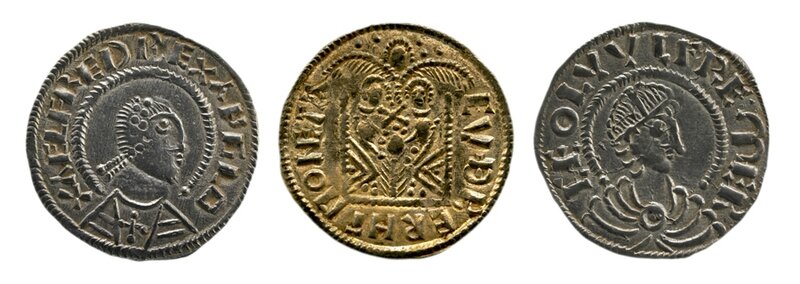Ashmolean Museum raises £1.35 million to acquire the hoard of King Alfred the Great
The Alfred Jewel. Gold, enamel and rock crystal, 6.2 x 3.1 x 1.3 cm. Anglo-Saxon, late 9th century. © Ashmolean Museum, University of Oxford.
OXFORD.- The Ashmolean Museum has raised the £1.35 million required to purchase the hoard of King Alfred the Great discovered in Watlington, Oxfordshire, in 2015. More than 700 members of the public contributed to the appeal. Lead support was provided by the National Lottery through a Heritage Lottery Fund (HLF) grant of £1.05 million to acquire the hoard and fund a range of educational and outreach activities. With a further £150,000 from Art Fund and contributions from private individuals and the Friends and Patrons of the Ashmolean, the Museum reached its fundraising target within days of the deadline.
Dr Xa Sturgis, Director of the Ashmolean, says: ‘The Watlington Hoard is one of the most exciting and important acquisitions we have ever made, particularly significant because it was found in Oxfordshire. To be able to keep the hoard in the county and put it on display with the Ashmolean’s Anglo-Saxon collections, which include the world-famous Alfred Jewel, was an opportunity we could not miss. I am therefore profoundly grateful to the Heritage Lottery Fund and National Lottery players; to Art Fund; to our Friends and Patrons; and to the members of the public and the people of Oxfordshire who have been so generous in their support.’
Once formally acquired, the Museum will launch an HLF funded events and education programme for the hoard. This will begin on 11 February when the treasures will be put on display at the Oxfordshire Museum, Woodstock (until 19 March). In collaboration with Oxfordshire Museums Service, the Ashmolean will stage roadshow events around the county which will include talks, object handling sessions and displays of the objects at locations including Bicester, Faringdon and of course in Watlington. The hoard will also be the focus at the Ashmolean’s annual Festival of Archaeology which takes place every year in July.
The 'Two Emperor’s Coin', Alfred the Great, king of Wessex (r.871–99) and Ceolwulf II of Mercia (r.874–c.879). Photo Credit Portable Antiques Scheme.
Stuart McLeod, Head of HLF South East, says: ‘This is fantastic news for the Ashmolean and its visitors. Thanks to the fundraising campaign and the £1.05 million provided by National Lottery players, this hugely significant hoard will be available for future generations to admire, learn from and explore.’
The Watlington hoard was discovered on private land by metal-dectorist James Mather on 7 October 2015. On the verge of giving up after a frustrating day of finding nothing more than ring-pulls and shotgun cartridges, James chanced upon an object he recognised to be a Viking-age ingot. On finding a further cache of silver pennies close-by he realised he had discovered a hoard. In the days following, James, the landowner and archaeologist David Williams of the British Museum’s Portable Antiquities Scheme, explored the site and then block-lifted the hoard out of the soil so that it could be taken to the British Museum to be excavated under laboratory conditions. Here it was x-rayed to reveal the contents and the arrangement of the objects within the soil.
Comprising about 200 coins (some of them fragmentary), seven items of jewellery and fifteen ingots (bars of silver), the find is not particularly large, but it is hugely significant because it contains so many coins of Alfred the Great, king of Wessex (r.871–99) and his less well known contemporary, Ceolwulf II of Mercia (r.874–c.879). The vanishingly rare ‘Two Emperors’ penny, of which the hoard contains thirteen examples, shows these two kings seated side-by-side below a winged figure of Victory or an angel. Prior to the discovery of the hoard, only two other examples of the ‘Two Emperors’ were known. The image on the coins suggests an alliance between the kingdoms of Wessex and Mercia. This, remarkably, challenges the accounts found in written sources which dismissed Ceolwulf as a puppet of the Vikings. The coins can therefore offer new insights into this tumultuous period of England’s history and allow us to speculate on Ceolwulf’s disappearance and what role Alfred might have played in his rival’s demise.
King Alfred’s Coins. Photo Credit: Trustees of the British Museum.
King Alfred’s Coins. Photo Credit: Trustees of the British Museum.
Eleanor Standley, Curator of the Ashmolean’s Anglo-Saxon and Medieval Collections, James Mather, who discovered the Watlington Hoard, and John Naylor, the Ashmolean's Medieval and Post-Medieval Portable Antiquities Scheme Finds Adviser.

/https%3A%2F%2Fprofilepics.canalblog.com%2Fprofilepics%2F1%2F0%2F100183.jpg)
/https%3A%2F%2Fstorage.canalblog.com%2F03%2F02%2F119589%2F96711876_o.jpg)
/https%3A%2F%2Fstorage.canalblog.com%2F11%2F31%2F119589%2F94773502_o.jpg)
/https%3A%2F%2Fstorage.canalblog.com%2F20%2F83%2F119589%2F94772815_o.jpg)
/https%3A%2F%2Fstorage.canalblog.com%2F26%2F72%2F119589%2F75604929_o.jpg)
/https%3A%2F%2Fstorage.canalblog.com%2F59%2F60%2F119589%2F26458628_o.jpg)







/image%2F1371349%2F20240423%2Fob_b2fe42_telechargement-9.jpg)
/image%2F1371349%2F20240423%2Fob_af8bb4_telechargement-6.jpg)
/image%2F1371349%2F20240423%2Fob_b6c4a6_telechargement.jpg)
/image%2F1371349%2F20240423%2Fob_981d5f_h22891-l367411650-original.jpg)